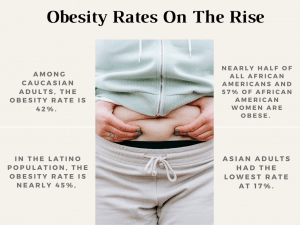There are a few things that aren’t a secret to any of us living in the U.S. One: our obesity rate is high, and is only getting higher. Two: we tend to live by the motto “go big or go home,” and that includes how we dish out our food. A lot of us have suspected for a long time that these two things are related, although many people have been stuck on the idea that it’s our supposedly sedentary lifestyles that’s caused the skyrocketing obesity rate in our country. But now, a recent report has charted how increasing obesity rates and increasing portion sizes in this country have run parallel to each other, and many frankly aren’t all that surprised.
The Skyrocketing Obesity Rate
It’s been said before, the obesity rate in this country has been rising for a long time, and it doesn’t seem to be slowing down, so it’s worth taking a good look at the numbers. According to the CDC, from 1999-2000 through 2017-2018, the percentage of people in the U.S. who were obese increased from 30.5% to 42.4%, and severe obesity increased from 4.7% to 9.2%. That means that obesity-related conditions like heart disease, stroke, type 2 diabetes, and certain types of cancer are also on the rise, unfortunately.
And the pandemic certainly hasn’t helped. The newest data from the CDC shows 16 states now have obesity rates of 35% or higher, which is an increase of four states: Delaware, Iowa, Ohio and Texas. To put that into perspective, in 2011, not a single state had reached the threshold of 35% obesity, and now, among the 16 at that level, a handful are close to 40%. 
And, as with other issues in our country, the obesity epidemic seems to be hitting minority communities particularly hard. There are big racial differences in the impact of obesity: A separate CDC survey from 2017-2018 showed:
- Nearly half of all African Americans and 57% of African American women are obese.
- In the Latino population, the rate is nearly 45%, while among Caucasian adults the rate is 42%.
- Asian adults had the lowest rate at 17%.
Some studies also suggest that poverty and rates of obesity go hand-in-hand, as well.
Even if you knew we had a bit of a problem in this country, those numbers are pretty shocking. And while there are a lot of factors that go into this obesity epidemic, the portion sizes that we find acceptable and normal seem to be getting bigger at the same rate that our waistlines do.
Out-of-Proportion Portions
It’s been made clear that the rising obesity rate is a problem in this country, and that there are probably multiple factors contributing to it. We’ve also been told that eating right – and not overeating – is one of the keys to maintaining a healthy weight. But it’s not always made clear that we’re actually consuming much, much bigger portions of things than we should be – or that we used to be.
So no, it’s not your imagination: the sizes of the packaged and fast foods that are for sale have been getting bigger and bigger, despite the fact that recommended serving sizes for these types of not-so-healthy food is certainly not getting any bigger. In fact, according to a recent report published in the American Journal of Public Health (AJPH), the size of packaged foods and fast food items in America has increased between two and five times the previous normal serving sizes when originally introduced, and those increases run directly parallel to the rise in obesity in this country. Not only that, but many products have not changed their sizes since 2002 recommendations that recommended they do so, with packages still up to five times bigger than they were previously.

You might be thinking that food companies are simply bowing to consumer pressure to give value for money, but the problem here goes beyond our wallets. In fact, if anything, these supersized portions are costing our country a whole lot of money in healthcare and lost wages for those who become ill because of excess weight. As the AJPH study points out, “To consumers, large portions may appear as a bargain, but they contain more calories and encourage overeating.”
And yes, the food industry is required to tell you on packaging what a “serving size” actually is, but that doesn’t seem to help much when the amount of food being sold is so far beyond that serving size. According to Lisa Young, PhD, RDN, a lead researcher for the AJPH report, “Larger packaged portions lead to overeating because people pay little attention to the size of their portions, focusing instead on what they are eating. Research also shows that we eat more when presented with more food—even if we are not hungry and don’t like the food.”
Portions Matter
The processed and fast food industries definitely make it easy to overeat the things we really shouldn’t be overeating, but you might also be thinking: isn’t it really about moving our bodies more? And yes, exercise is incredibly important for our overall health and maintaining a healthy weight, but we’d like to add to the study above another, and far more surprising, study. According to Dr. Herman Pontzer, an evolutionary biologist, “Your brain is very, very, very good at matching how many calories you eat and how many calories you burn. The person who has a sedentary lifestyle and the person who has the active lifestyle will burn the same number of calories.”
He thinks that we are looking at our “body’s flexible metabolic engine,” which according to his research, constantly adjusts depending on what we eat and how much we move, in the wrong way, and that we cannot achieve the weight loss we want from exercise alone. According to him, the amount we consume just makes way more of an impact.
His theory comes from studying the Hadza people of Tanzania, hunter-gatherers who walk for miles every day looking for food, meaning they’re constantly in motion, and get more exercise in a day than most Americans do in a week. Pontzer and his colleagues were sure that would also mean that they burn a ton more calories than we do, but surprisingly, when the researchers measured how much energy the Hadza burned, it turned out to be the same amount as most of their more sedentary Western counterparts.
The takeaway? While there’s some disagreement about how little exercise matters to weight loss, most research does point to the fact that what you eat and how much of it is really, really important.
Portion Control
The authors of the AJPH study want to see things like price incentives for selling smaller portion sizes of ultra-processed foods, larger sizes discontinued, and even restrictions on marketing of large portions. But there are also ways that you can help yourself keep your portions sensible. Try:
- Buying single-serve items – You’re not too likely to reach for multiple, single-serve bags of chips!
- Make your own snack packs – If buying bigger packages is better for your budget, try making your own single-serve packs.
- Use smaller plates and bowls – It sounds silly, but the size of your plates and bowls really does make a difference! The bigger they are, the smaller your portion looks to you, and vice versa.
- Do some measuring – You don’t have to go crazy weighing all of your food, but it is useful to know how much a cup serving size actually is.
- Add more fruits and veggies into your diet – You don’t need to worry too much about how many fruits and veggies you’re eating, and the fiber in them will fill you up. Having trouble finding or affording the fresh stuff? Frozen or even canned is just as good.
- Take a beat – Before you snack, think. Studies show that thinking about your last meal and reviewing what you ate during the day (even keeping a food journal) helps you to consume fewer calories.
- Drink more water – Studies have found that people who drink at least 2 glasses of water before meals can lose 30% more weight than those who don’t, so stay hydrated and keep yourself fuller!
- Eat more protein – Getting enough protein in your diet can help to curb overeating. In fact, in one study, people who ate a low-protein diet reported feeling hungrier and ate 12% more calories throughout the day than those who consumed more of the muscle-building nutrient. This 12% could add up to an extra 2.2 pounds of weight gain per month, or more than 26 pounds a year.
- Give yourself a hand – You can use a literal rule of thumb to remind yourself of portion sizes. A serving of fat should be about the size of your thumb, a true serving of rice or pasta is about the size of your fist, and lean meats should be about the size of your palm.
We’re living in a supersized world, and that can wreak havoc on our health and waistlines. But with a little bit of knowledge about portion sizes, eating the right foods in the right amounts, and getting the exercise we need, we can navigate it, and keep ourselves fit, healthy, and happy!